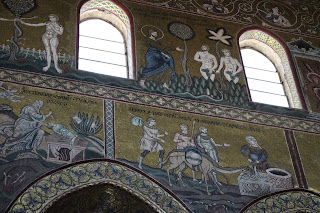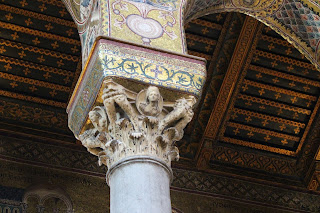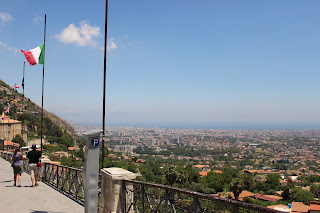On Monday, June 12th, the group met our local guide, Jacqueline Alio, whose book on Sicilian history I had read most of before leaving for Europe. She was passionate about Sicily’s importance in European and world history, and how Palermo was as worthy of attention as Rome, Florence or Venice, but had been ignored, slighted and exploited by the Italian powers-that-be ever since the unification of the country in the 1860s. We went to the Quattro Canti, the elegant, early-17th-century piazza where two major streets and the old town’s four quarters meet. Then we went to the so-called “Fountain of Shame”—16th-century Palermitans were shocked by the nudity of the sculptures.
Then we went into the Santa Caterina church. After that, we walked to and through the Balarò market.
Next, we got on the bus and rode up to the suburb of Monreale, where the Norman kings had built a palace and created an alternate ecclesial power center to Palermo. We walked up the hill (Virginia got Mary Joy and another tour member a taxi) to the Cathedral, and viewed its spectacular mosaics. Then we had lunch at a restaurant with a view out over Palermo, far below. Then, we all visited the cloister of the 12th-century monastery, with its graceful columns and wonderful sculpted capitals.
Back in Palermo and on our own, Mary Joy and I got a glimpse of the Martorana Church before a wedding (complete with video drone!) started. Then we visited the much smaller, much plainer neighboring San Cataldo.
Next, we walked up to Palermo’s massive opera house, the Teatro Massimo, and, after having granitas in the café, took a half-hour tour of the building, in Italian and English.
Our last bit of tourism for the day was to visit the Cathedral, which is much more impressive on the Norman outside than on the baroque inside.
Our first two choices for dinner were full, so we ended up back at the Quattro Canti, at Bisso Bistrot, which turned out to be Mary Joy’s favorite restaurant of the whole trip, more for the vibe than for the (very good) food. We were put on the list and told to expect a twenty-minute wait, but after less than ten minutes, which we spent watching a religious procession in the street outside. We were seated in the middle two seats of a six-seat table, with a young Italian couple (from Milan, though he was originally from Sicily) toward the wall and two Italian men, 40s-ish, on the aisle. On the waiter’s insistence, Mary Joy started with a crudo plate of raw tuna and other seafood. I forget what else we had, but it was very good.



















































































No comments:
Post a Comment